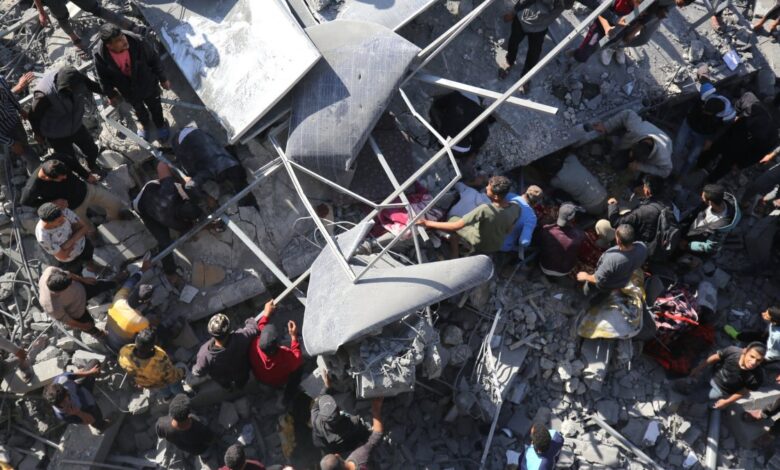Has Israel shifted focus from annihilating Hamas? Analysts suggest a new direction in conflict resolution.

Fierce urban fighting continued in Gaza on Monday as Israeli officials claimed to be close to achieving the primary war aim of destroying Hamas, but independent analysts believe Tel Aviv may have quietly accepted that this goal is unrealistic. A senior Israel Defence Force (IDF) officer said that the militant group is “breaking” under the weight of Israel’s bombardment, with the army reporting that it has struck more than 22,000 targets in the besieged enclave. Government spokesman Eylon Levy said that “Hamas’ grip on power is collapsing” and “its men’s morale is crumbling” after images purporting to show dozens of militants surrendering emerged. Palestinian sources claimed that some of the alleged fighters were civilians. IDF spokesperson Lieutenant Colonel Peter Lerner told i that Hamas “is in a state of disarray based on their ability to coordinate attacks against us… there is a disconnect between the leadership and their operatives”. Lt Col Lerner said that an unspecified number of senior Hamas commanders had been killed but acknowledged that the group’s senior leadership and the majority of Hamas’s 30,000-strong force remained intact. Hamas sources and witnesses reported clashes between militants and Israeli tanks in Khan Yunis on Monday, the largest city in southern Gaza that has become a focus of Israeli attacks. The militant group also claimed to have launched attacks on Israeli forces in Jabalia in northern Gaza, where Israel claims to control most of the territory.
The Humanitarian Situation
The situation on the ground in Gaza is dire, with the toll on civilians continuing to mount as the conflict rages on. The Palestinian death toll in Gaza reached 18,205 on Monday, according to the Gaza Health Ministry, a department of the Hamas government whose numbers have been deemed reliable by the UN. The ministry figures do not distinguish between civilians and combatants. The UN claims that around two-thirds of casualties are civilians. The Israeli death toll rose by eight to 104 since the ground invasion was launched on 27 October. More than 1,200 Israelis were killed during the deadly Hamas raids of 7 October. The UN has warned of widespread starvation in the enclave due to aid shortages, while the Israeli government claims that aid is available but the UN is failing to distribute it.
Challenges and Criticisms
Independent analysts are sceptical that Israel is close to achieving its primary war aim of “eradicating” Hamas. Hugh Lovatt, a Middle East specialist at the European Council on Foreign Relations, said that “while Hamas is suffering losses… clearly it is still a fighting force. It is still a coherent organisation in Gaza. And it is still taking the fight to Israeli forces”. Mr Lovatt suggested that the Israeli statements suggesting a Hamas collapse may be aimed at showing progress to the Israeli public, as well as “trying to construct a victory narrative” short of the total destruction of Hamas, amid growing international pressure to curtail the fighting. Colin Clarke, a terrorism and counterinsurgency researcher at the Soufan Group think tank in the US, suggested that Israel’s claims might indicate a scaling back of its war aims. “I think there’s something to the argument that Israel has recognised the folly of declaring the eradication of Hamas as its overarching objective,” he told i. “It is nearly impossible to completely destroy a terrorist group like Hamas, which has a comprehensive military and political wing as well as support among Palestinians in both Gaza and the West Bank”.
International Response and Humanitarian Crisis
A group of UN Security Council envoys travelled to the Rafah border crossing between Egypt and Gaza after UN Secretary General Antonio Guterres warned of widespread starvation in the enclave due to aid shortages. “The reality is even worse than what words can speak,” said Ecuador’s UN representative Jose De La Gasca after a briefing from UN agency UNRWA, which is managing aid distribution. UNRWA chief Phillipe Lazzarini said “hunger is prevailing in Gaza. More and more people haven’t eaten for one day, two days, three days”. The UN General Assembly is expected to vote on a draft resolution demanding an immediate humanitarian ceasefire, after the US vetoed a UN Security Council vote on a ceasefire. The humanitarian crisis has been exacerbated by the fact that five hospitals in Gaza have come under fire since the start of the weekend. Several healthcare facilities across the Strip have been severely limited in their ability to deliver emergency services during the war.
Hostage Situation and Regional Escalation
Hamas warned that none of the hostages it is holding would return alive without an agreement over a prisoner exchange on the group’s terms. “Neither the fascist enemy and its arrogant leadership… nor its supporters… can take their prisoners alive without an exchange and negotiation and meeting the demands of the resistance,” said spokesperson Abu Obeida. Hamas is believed to hold more than 130 hostages, mostly men, after releasing most of the women and children it was holding during a seven-day truce last month. The group has proposed an “all for all” exchange for more than 6,000 Palestinian prisoners held in Israeli jails. Separately, Israel claimed to have struck several Hezbollah targets in southern Lebanon after the group launched rocket attacks into northern Israel.



